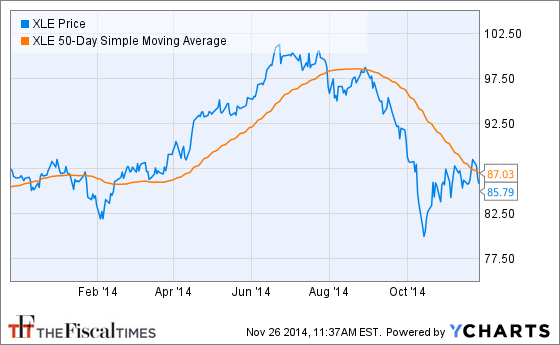On Thanksgiving morning, when millions of Americans rise bright and early to start preparing their turkey dinners and draw up their post-meal shopping strategies, Saudi Arabia, the de-facto leader of the Organization of Petroleum Exporting Countries or OPEC, could deliver a surprise that may very well spoil the holiday shopping season for many.
I'm talking about the potential for a surprise crude oil production cut, which if it happened, would catch investors on Wall Street wrong footed and pinch consumer confidence heading into the most important time of the year for retail sales.
Related: Investors Thankful for the Market’s Recent Strength
Focus has shifted to what's happening with crude oil ahead of the most important OPEC meeting in years on Thursday. Oil futures are down more than 32 percent from their high in June, putting pressure on Saudi Arabia — seen as the world's largest swing player in energy — to cut production to bolster prices. Excess supply, as well as a near-term lull in demand growth and a powerful rally in the U.S. dollar, has been responsible for the decline.
Complicating the situation is the increased reliance oil producers like Russia have on high energy prices to fund public budgets.
So no oil producer wants to cut production, since that will reduce revenue. But no producer wants to see oil prices collapse if action isn't taken, as is widely expected. Oil was dragged lower in Tuesday's session on reports that a meeting of OPEC members Saudi Arabia and Venezuela with non-OPEC countries Russia and Mexico failed to produce any agreement on production cuts. Additional comments from Russia suggested the country wouldn't be worried if oil fell below $60 a barrel from near $74 now.
Subsequent headlines that Saudi Arabia may support efforts to force OPEC countries to honor current production agreements — as a backwards way of reducing supply — provided merely a short-lived bounce in oil that was fully reversed into the close. The trading action suggests tensions are high with the potential for a large magnitude post-meeting price swing on Thursday when U.S. markets are closed.
Jan Stuart at Credit Suisse believes that if Saudi Arabia, via OPEC, doesn't deliver, "oil prices will quickly fall a lot further." While this would be good news for consumers, it could potentially be a negative factor for stocks since the S&P 500 has much more exposure to energy companies than retailers. Already, as shown above, the Energy Sector Select SPDR (XLE), which tracks the energy stocks in the S&P 500, is weakening in a way that hasn't been seen since early September.
Related: ISIS, Broken in Iraq, Emerges in Saudi Arabia
But what if the Saudis realize prices have fallen too far and too fast, given their need for crude oil near $92 to balance their budget, according to Deutsche Bank? Russia needs it near $100; Iran, closer to $140. Kuwait is on the low end, needing just $70 a barrel. Credit Suisse’s Stuart believes that we would need to see a production cut of around 1 million barrels per day from Saudi Arabia, Kuwait, and the United Arab Emirates to stem the tide.
WTI Crude Oil Spot Price data by YCharts
It's hard to judge what the impact on oil prices would be of a production cut of this size, but a rise to test the 50-day moving average near $83 a barrel seems reasonable. That would be worth a gain of more than 12 percent from current levels. At the pump, gasoline prices, as a rough estimate, would rise by about 20 to 30 cents a gallon.
What would be the impact to Christmas shopping? The American Research Group estimates that the average consumer will spend $861 on gifts this year (up 8 percent from 2013) and that only 38 percent have already started shopping. A team of researchers at Credit Suisse led by Edward Kelly estimates that the drop in gas prices since July would add about $770 dollars per year to the wallet of a household earning $40,000 per year.
Related: What Could Stop This Unstoppable Stock Market Rally
In other words, the drop in gas prices, if sustained, would nearly be enough to cover the cost of holiday shopping. A 30-cents-a-gallon rebound in gas prices, on an annual basis, would cost about $210. For comparison, the end of the payroll tax cut in 2011 cost about $800, higher health care prices are costing about $115 a year, and higher food prices are costing about $138 a year.
While a modest rebound in prices at the pump probably isn't enough to completely undermine holiday shoppers, it could turn what would've been a very merry Christmas into merely a mediocre one for many low-income consumers — folks that are already disproportionally feeling the impact of the reversal of government stimulus efforts. This includes the rollback of food stamp benefits last November.
If it happens, send your complaints to Ali Al-Naimi, the kingdom's Minister of Petroleum and Mineral Resources in Riyadh.
Top Reads from The Fiscal Times:
- Benghazi Hearing No. 8: Most Americans Don’t Care
- Keystone XL Pipeline: No Oil, Plenty of Propaganda
- Why Wall Street Breeds So Many Bad Apples






